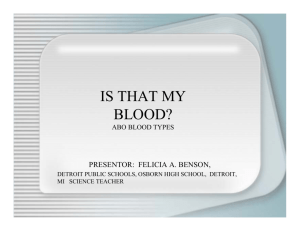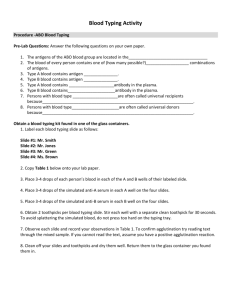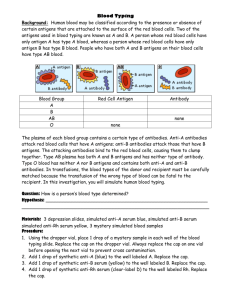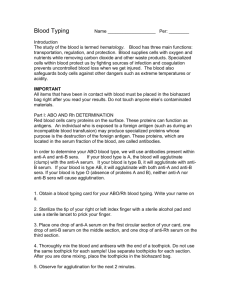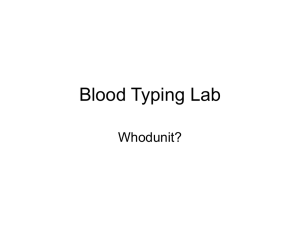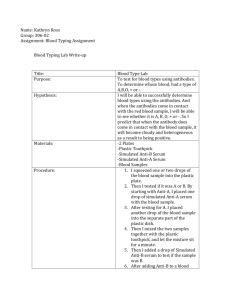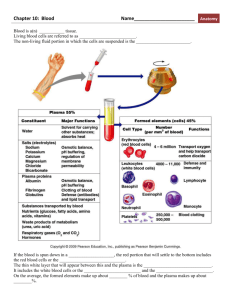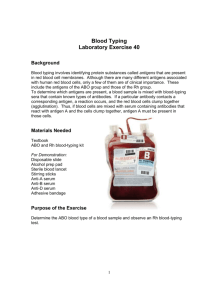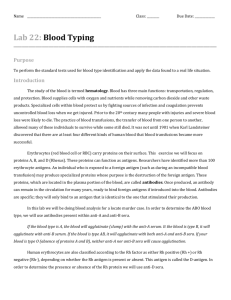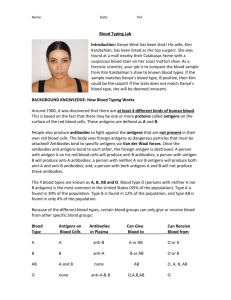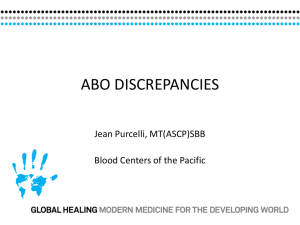blood typing lab and questions
advertisement
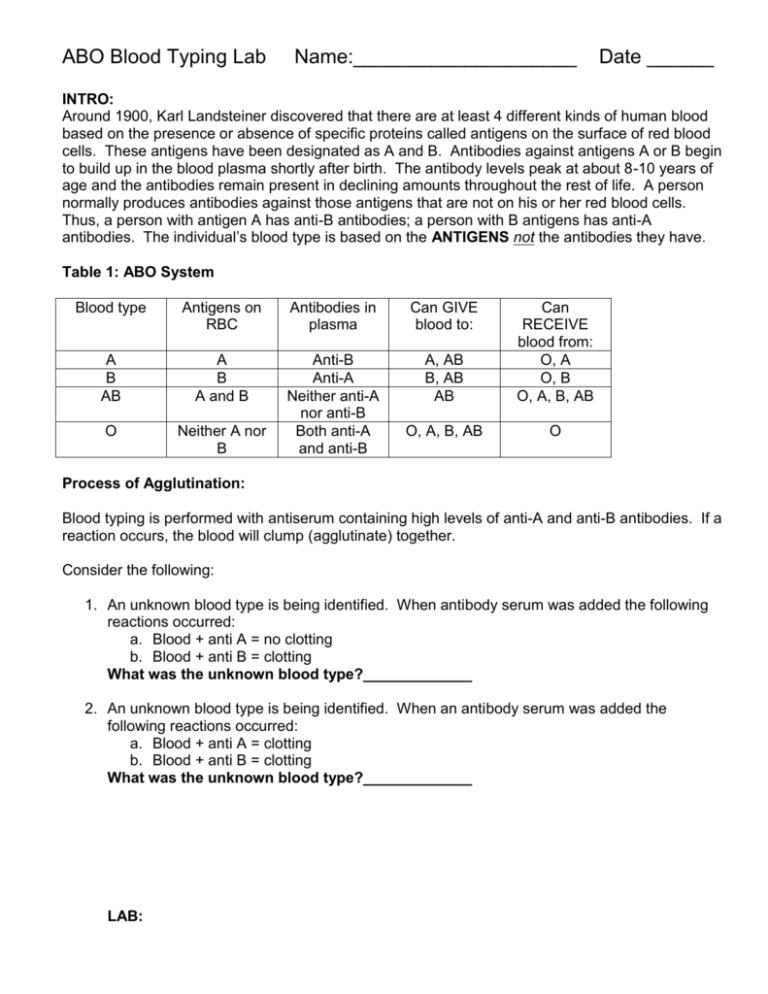
ABO Blood Typing Lab Name:____________________ Date ______ INTRO: Around 1900, Karl Landsteiner discovered that there are at least 4 different kinds of human blood based on the presence or absence of specific proteins called antigens on the surface of red blood cells. These antigens have been designated as A and B. Antibodies against antigens A or B begin to build up in the blood plasma shortly after birth. The antibody levels peak at about 8-10 years of age and the antibodies remain present in declining amounts throughout the rest of life. A person normally produces antibodies against those antigens that are not on his or her red blood cells. Thus, a person with antigen A has anti-B antibodies; a person with B antigens has anti-A antibodies. The individual’s blood type is based on the ANTIGENS not the antibodies they have. Table 1: ABO System Blood type Antigens on RBC Antibodies in plasma Can GIVE blood to: A B AB A B A and B A, AB B, AB AB O Neither A nor B Anti-B Anti-A Neither anti-A nor anti-B Both anti-A and anti-B Can RECEIVE blood from: O, A O, B O, A, B, AB O, A, B, AB O Process of Agglutination: Blood typing is performed with antiserum containing high levels of anti-A and anti-B antibodies. If a reaction occurs, the blood will clump (agglutinate) together. Consider the following: 1. An unknown blood type is being identified. When antibody serum was added the following reactions occurred: a. Blood + anti A = no clotting b. Blood + anti B = clotting What was the unknown blood type?_____________ 2. An unknown blood type is being identified. When an antibody serum was added the following reactions occurred: a. Blood + anti A = clotting b. Blood + anti B = clotting What was the unknown blood type?_____________ LAB: ABO Blood Typing Lab Name:____________________ Date ______ Objective: to determine the ABO blood type of 4 unknown simulated blood samples Materials: Blood typing slide Toothpicks Shared Materials: 5 unknown simulated blood samples o Persons V, W, X, Y, Z Anti-A Serum Anti-B Serum Procedure: 1. Pre-Label each of your 4 blood typing slides as follows: a. Person V b. Person W c. Person X d. Person Y e. Person Z 2. Place 3-4 drops of Person V blood in each of the A, B wells of slide #1 3. Place 3-4 drops of Person W blood in each of the A, B wells of slide # 2 4. Place 3-4 drops of Person X blood in each of the A, B wells of slide # 3 5. Place 3-4 drops of Person Y blood in each of the A, B wells of slide # 4 6. Place 3-4 drops of Person Z blood in each of the A, B wells of slide # 5 7. Add 3-4 drops of the anti-A serum in each A well on the four slides. 8. Add 3-4 drops of the anti-B serum in each B well on the four slides. 9. Use separate toothpicks to stir each sample of serum and blood. RECORD your observations and results in the table below. Table 2: Agglutination Reactions Anti-A serum Anti-B serum Blood Type Observations Person V Person W Person X Person Y Person Z (a positive test is indicated by a strong agglutination (clumping) reaction) Analysis of Results: 1. What ABO antigens are present on the red blood cells of Person W’s blood? ABO Blood Typing Lab Name:____________________ Date ______ 2. What ABO antibodies are present in the plasma of Person X’s blood? 3. What ABO antibodies are present in the plasma of Person Z’s blood? 4. If Person X needed a transfusion, what ABO type(s) of blood could he receive? 5. If Person Y were serving as a donor, what ABO blood type(s) could receive her blood safely? 6. Why is it necessary to match the donor’s and the recipient’s blood before a transfusion is given? 7. What is the difference between an antigen and an antibody? 8. Explain the basis of ABO blood types. 9. Could a man with AB blood be the father of an O child? 10. Could a man with O blood type be the father of an AB child? 11. Could a Type B child with a Type A mother have a Type A father? 12. What are the possible genetic combinations of an offspring when the blood types of the parents are A and B?
